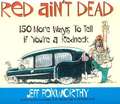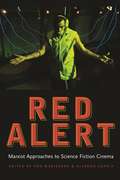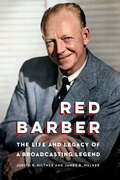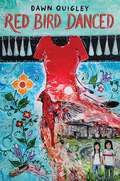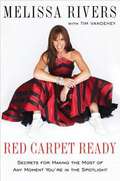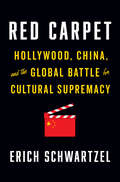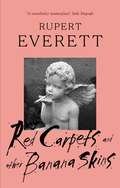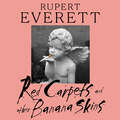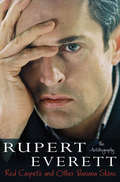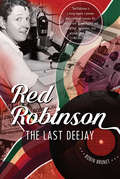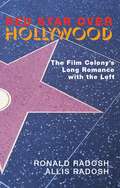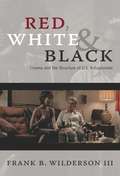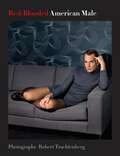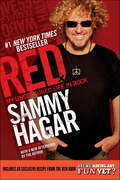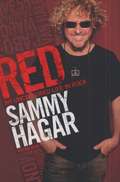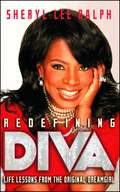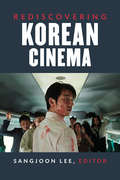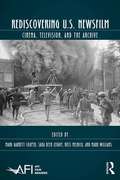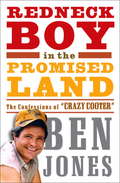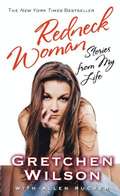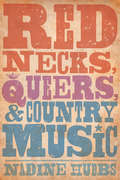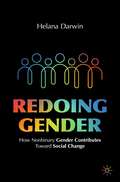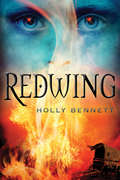- Table View
- List View
Red Ain't Dead: 150 More Ways To Tell If You're A Redneck
by Jeff FoxworthyIt is true, as you may have heard, that a comedian's jokes are like his children. You conceive them (not nearly as much fun as with real kids), nurture them, and eventually let them go. Like real children, some are cute, some are bad, and once in a while one exceeds every expectation you ever had for it. That was the case with my "Redneck" jokes. Appropriately conceived in a cheap motel in Huntsville, Alabama, they quickly grew into more than a comedy bit or even a best-selling book. They became a part of my life. People stop me in airports or on streets and say, "Hey, you're the Redneck guy! And I'm one of 'em!" Excerpts from the first book, YOU MIGHT BE A REDNECK IF..., have been copied, modified, and faxed from workplace to workplace. The material has been "borrowed" by newspapers, wire services, and radio stations nationwide. I feared we had beaten the subject to death, but not a day goes by that someone doesn't offer me a new example of "redneckism." I have received photos of front-yard flower pots made out of old toilets, and newspaper clippings of grooms wearing Harley-Davidson tee-shirts. With the help of my wife and friends, I add several to the list almost daily. I have collected numerous Redneck lines from radio audiences and even from my live show audiences. I must admit that I am very proud of my "Redneck child." I am even happier that others love it as I do. So for all those people, here is a second helping. Though conventional wisdom says you can't believe everything you read, in this case I assure you that you can. Red ain't dead. - Jeff Foxworthy
Red Alert: Marxist Approaches to Science Fiction Cinema (Contemporary Approaches to Film and Media Series)
by Ewa Mazierska Alfredo SuppiaIn Red Alert: Marxist Approaches to Science Fiction Cinema, editors Ewa Mazierska and Alfredo Suppia argue that Marxist philosophy, science fiction, and film share important connections concerning imaginings of the future. Contributors look at themes across a wide variety of films, including many international co-productions to explore individualism versus collectivism, technological obstacles to travel through time and space, the accumulation of capital and colonization, struggles of oppressed groups, the dangers of false ideologies, and the extension of the concept of labor due to technological advances. Red Alert considers a wide swath of contemporary international films, from the rarely studied to mainstream science fiction blockbusters like The Matrix. Contributors explore early Czechoslovak science fiction, the Polish-Estonian co-productions of director Marek Piestrak, and science fiction elements in 1970s American blaxploitation films. The collection includes analyses of recent films like Transfer (Damir Lukacevic), Avalon (Mamoru Oshii), Gamer (Mark Neveldine and Brian Taylor), and District 9 and Elysium (Neill Blomkamp), along with more obscure films like Alex Rivera's materialist science fiction works and the Latin American zombie films of Pablo Parés, Hernán Sáez, and Alejandro Brugués. Contributors show that the ambivalence and inner contradictions highlighted by the films illustrate both the richness of Marx's legacy and the heterogeneity and complexity of the science fiction genre. This collection challenges the perception that science fiction cinema is a Western or specifically American genre, showing that a broader, transnational approach is necessary to fully understand its scope. Scholars and students of film, science fiction, and Marxist culture will enjoy Red Alert.
Red Barber: The Life and Legacy of a Broadcasting Legend
by James R. Walker Judith R. HiltnerBorn and raised in rural Mississippi and the even balmier climes of central Florida, Red Barber, at the age of thirty-two, became one of New York City&’s most influential citizens as the play-by-play announcer for the Brooklyn Dodgers. When he arrived in 1939, Barber brought the down-home drawl and idioms of his southern roots to the borough, where residents said they could walk down any street and never miss a pitch because his voice wafted out of every window and every passing car. From his colorful expressions like &“rhubarb&” and &“sitting in the catbird seat&” to his vivid use of similes—a close game was &“tighter than a new pair of shoes on a rainy day&”—Barber&’s influence on his contemporaries and the many generations of broadcasters who followed him cannot be overstated. But behind all the base hits, balls, and strikes lies a compelling story that dramatizes the shifting expectations and roles of a public figure—the sports broadcaster—as he adapted to complex cultural changes throughout the course of twentieth-century American life.Red Barber follows the trajectory of Barber's long career from radio and television play-by-play man for the Cincinnati Reds, Brooklyn Dodgers, and New York Yankees to his work calling college and professional football games, his nine-year tenure as director of sports for CBS Radio, and his second acts as an Episcopal lay reader, sportswriter, and weekly guest with Bob Edwards on NPR&’s Morning Edition. This talented public figure was also a private man committed to rigorous self-examination and willing to evolve and grow under the influence of changing times. When the Dodgers first signed Jackie Robinson and smashed the color barrier in Major League Baseball, Barber struggled to overcome the racism he had absorbed from his culture as a child. But after observing the vicious abuse Robinson endured from opposing fans, Barber became an ardent supporter of him and the many Black players who followed. Barber was also bothered deeply by the strains that his single-minded careerism imposed on his family. He was challenged to navigate longtime family tensions after his only child, Sarah, came out as a lesbian. And his primary role during the later years of his life was caretaking for his wife, Lylah, during her decline from Alzheimer&’s disease, at a time when the ailment was something many families concealed. Ultimately Red Barber traces the career of a true radio and television pioneer who was committed to the civic responsibility of mass media. Barber firmly believed the most important role of a broadcaster was telling the truth and promoting public well-being.
Red Bird Danced
by Dawn QuigleyWith lyrical verse and powerful emotion, Dawn Quigley (Ojibwe) tells the story of urban Native kids who find strength in connection with those who came before and in the hope that lets them take flight. Ariel and Tomah have lived in the city’s intertribal housing complex all their lives. But for both of them, this Dagwaagin (Autumn) season is different than any before.From his bench outside the front door of his building, Tomah watches his community move around him. He is better at making people laugh than he is at schoolwork, but often it feels like his neighbor Ariel is the only one who really sees him, even in her sadness. Ariel has always danced ballet because of her Auntie Bineshiinh and loves the way dance makes her feet hover above the ground like a bird. But ever since Auntie went missing, Ariel’s dancing doesn’t feel like flying.As the seasons change and the cold of winter gives way to spring’s promise, Ariel and Tomah begin to change too as they learn to share the rhythms and stories they carry within themselves.This first middle grade novel by Dawn Quigley is a tour de force. She is known for her American Indian Youth Literature Award–winning Jo Jo Makoons chapter book series and young adult novel Apple in the Middle. Give Red Bird Danced to readers who love Jasmine Warga and Christine Day!
Red Carpet Ready: Secrets for Making the Most of Any Moment You’re in the Spotlight
by Melissa Rivers Tim VandeheyBe ready the next time the spotlight is on you! She's interviewed "glamazons," watched stars shine (Sharon Stone in a Gap T-shirt at the Oscars) and bomb (Jennifer Aniston in dreadlocks, Cher in an Egyptian headdress), and witnessed many a celebrity rise to the top only to come crashing down a mere year later. And she's both reveled in kudos and despaired over criticism of herself. As the daughter of Joan Rivers and with years of face time with the Hollywood elite, Melissa has learned far more than your average person about what it takes to be a star-not just on the red carpet, but in life. For the first time, she shares the lessons she's learned along the way and teaches you how to embrace your big moments, be it a graduation, a first date, a job interview, a prom, or a wedding. Pulling from inspirational and humorous tales from her probing chats with red-carpet royalty and episodes in her own life, she lays out nine essential rules to seize momentous times with graciousness, fun, preparedness, confidence-and, of course, drop-dead gorgeous style that flatters you. (Hint: It's not always the top designer brand that'll scream stardom.) The walk down the red carpet, as Rivers so colorfully relates, can teach us all some basic but essential lessons in fashion and in life. With miles of red carpet under her belt, Melissa Rivers has seen it all, from the biggest oops! moments to those unforgettable times when a star truly did shine. She knows exactly what it takes to be a star-both on the red carpet and in life. Based on her insider knowledge and her personal experience under Hollywood's glare, Melissa shares tips and techniques for embracing your momentous times and being at your best when the focus is on you, including: * The simple trick to being the hit of every party * How to escape from a date that's become a train wreck * The celebrity secret to looking radiant, rain or shine * A success strate gy that beats pure talent every time * The one rule about people even the superstars are afraid to break * How to apologize or run into your ex and keep your cool.
Red Carpet: Hollywood, China, and the Global Battle for Cultural Supremacy
by Erich Schwartzel"This is a fascinating book. It will educate you. Schwartzel has done some extraordinary reporting." — The New York Times Book Review &“In this highly entertaining but deeply disturbing book, Erich Schwartzel demonstrates the extent of our cultural thrall to China. His depiction of the craven characters, American and Chinese, who have enabled this situation represents a significant feat of investigative journalism. His narrative is about not merely the movie business, but the new world order.&” —Andrew Solomon, author of Far from the Tree and The Noonday DemonAn eye-opening and deeply reported narrative that details the surprising role of the movie business in the high-stakes contest between the U.S. and ChinaFrom trade to technology to military might, competition between the United States and China dominates the foreign policy landscape. But this battle for global influence is also playing out in a strange and unexpected arena: the movies. The film industry, Wall Street Journal reporter Erich Schwartzel explains, is the latest battleground in the tense and complex rivalry between these two world powers. In recent decades, as China has grown into a giant of the international economy, it has become a crucial source of revenue for the American film industry. Hollywood studios are now bending over backward to make movies that will appeal to China&’s citizens—and gain approval from severe Communist Party censors. At the same time, and with America&’s unwitting help, China has built its own film industry into an essential arm of its plan to export its national agenda to the rest of the world. The competition between these two movie businesses is a Cold War for this century, a clash that determines whether democratic or authoritarian values will be broadcast most powerfully around the world. Red Carpet is packed with memorable characters who have—knowingly or otherwise—played key roles in this tangled industry web: not only A-list stars like Matt Damon, Angelina Jolie, and Richard Gere but also eccentric Chinese billionaires, zany expatriate filmmakers, and starlets who disappear from public life without explanation or trace. Schwartzel combines original reporting, political history, and show-biz intrigue in an exhilarating tour of global entertainment, from propaganda film sets in Beijing to the boardrooms of Hollywood studios to the living rooms in Kenya where families decide whether to watch an American or Chinese movie. Alarming, occasionally absurd, and wildly entertaining, Red Carpet will not only alter the way we watch movies but also offer essential new perspective on the power struggle of this century.
Red Carpets And Other Banana Skins
by Rupert Everett''Hilariously honest. . . a kind of rake's progress' Daily MailAn element of drama has always attended Rupert Everett, even before he swept to fame with his outstanding performance in 'Another Country'. He has spent his life surrounded by extraordinary people, and witnessed extraordinary events. He was in Moscow during the fall of communism; in Berlin the night the wall came down; and in downtown Manhattan on September 11th. By the age of 17 he was friends with Andy Warhol and Bianca Jagger, and since then he has been up close and personal with some of the most famous women in the world: Julia Roberts, Madonna, Sharon Stone and Donatella Versace. Whether sweeping the floor for the Royal Shakespeare Company or co-starring with Faye Dunaway and an orang-utan in 'Dunstan Checks In' (they both took ages to get ready), Rupert Everett always brings as much energy and talent to his life as he does to his career. A superb raconteur and a keen observer of human folly (especially his own), Rupert Everett turns his life into a captivating story of love, fame, glamour, gossip and drama.Praise for Red Carpets and Other Banana Skins'He has an almost fanatical loyalty to the concept of enjoyment, to the detriment, it might be argued, of his art, though to the great enrichment of his being; and for Rupert, as he makes clear in this continuously brilliant memoir, the best theatrical autobiography since Noël Coward's Present Indicative, acting is being...a superb and unexpectedly inspiring achievement' Simon Callow, Guardian'Lush, profoundly reflective, and thoroughly satisfying...a heady triumph of observation and reverie' Independent'What makes this autobiography a (novelistic) masterpiece is the way he is acutely aware of the melancholia and pain that are the other side of hedonism's coin' Daily Telegraph
Red Carpets And Other Banana Skins
by Rupert Everett''Hilariously honest. . . a kind of rake's progress' Daily MailAn element of drama has always attended Rupert Everett, even before he swept to fame with his outstanding performance in 'Another Country'. He has spent his life surrounded by extraordinary people, and witnessed extraordinary events. He was in Moscow during the fall of communism; in Berlin the night the wall came down; and in downtown Manhattan on September 11th. By the age of 17 he was friends with Andy Warhol and Bianca Jagger, and since then he has been up close and personal with some of the most famous women in the world: Julia Roberts, Madonna, Sharon Stone and Donatella Versace. Whether sweeping the floor for the Royal Shakespeare Company or co-starring with Faye Dunaway and an orang-utan in 'Dunstan Checks In' (they both took ages to get ready), Rupert Everett always brings as much energy and talent to his life as he does to his career. A superb raconteur and a keen observer of human folly (especially his own), Rupert Everett turns his life into a captivating story of love, fame, glamour, gossip and drama.Praise for Red Carpets and Other Banana Skins'He has an almost fanatical loyalty to the concept of enjoyment, to the detriment, it might be argued, of his art, though to the great enrichment of his being; and for Rupert, as he makes clear in this continuously brilliant memoir, the best theatrical autobiography since Noël Coward's Present Indicative, acting is being...a superb and unexpectedly inspiring achievement' Simon Callow, Guardian'Lush, profoundly reflective, and thoroughly satisfying...a heady triumph of observation and reverie' Independent'What makes this autobiography a (novelistic) masterpiece is the way he is acutely aware of the melancholia and pain that are the other side of hedonism's coin' Daily Telegraph
Red Carpets and Other Banana Skins: The Autobiography
by Rupert EverettRevealing himself to be a consummate storyteller, stage and screen star Everett ("My Best Friend's Wedding") pens a delightfully witty memoir in which he reveals his life experiences as an up-and-coming actor, detailing everything from the eccentricities of the British upper class to the madness of Hollywood.
Red Robinson: The Last Deejay
by Robin BrunetRed Robinson: The Last Deejay details the life and career of Red Robinson, one of Canada's most celebrated pioneers of rock and roll. Robinson began spinning hits while in high school in the early 1950s, laying the foundation for what would become a glamorous, impossible-to-stop and ultimately fulfilling career that has made him a household name west of the Rockies. <p><p> Raised by a single mother, Robinson worked as a delivery boy to help support the family. From such humble beginnings, he developed a strong work ethic and unflappable moral core that enabled him to pursue a career that has endured. Here is the account of how Robinson pranked his way into his first radio job. Readers will be delighted by behind-the-scenes stories from close encounters with Vancouver's visiting celebrities, like the time Robinson spent an hour with Elvis Presley in the BC Lions dressing room talking cars, women, movies and opera, or when Robinson nearly killed Roy Orbison and Bobby Goldsboro in a 1962 Grand Parisienne convertible while speeding to catch the Nanaimo ferry. <p> Robinson's vast career highlights are remarkable, from introducing The Beatles to the stage, ushering Randy Bachman to the status of superstardom, and as part of EXPO '86, presenting The Legends of Rock'n'Roll featuring Ray Charles, Roy Orbison, Fats Domino, Jerry Lee Lewis and The Righteous Brothers. Red Robinson: The Last Deejay recalls the highs, hurdles and triumphs of a celebrated time in rock-and-roll history, presented by the man who dug into the guts, glory and glitz that only a champion of the frontlines of music really can.
Red Star Over Hollywood: The Film Colony's Long Romance with the Left
by Ronald Radosh Allis RadoshUntil now, Hollywood's political history has been dominated by a steady stream of films and memoirs decrying the "nightmare" of the Red Scare and how it victimized political innocents. But in Red Star over Hollywood, Ronald and Allis Radosh tell for the first time the "backstory" behind this myth. The authors show how the Soviet Comintern decided to make the film capital a prime target in the late 1920s. They follow the lives of Budd Schulberg, Ring Lardner Jr., Maurice Rapf and other young radicals who journeyed to the USSR in the early 1930s, underwent a political conversion experience there, and came back to Hollywood as apostles preaching a Soviet gospel. They take us inside the cells and discussion groups that Communist Party members formed, the guilds and unions they tried to take over, and the studios they aimed to influence. The Radoshes not only prove that the members of the Hollywood Party were loyal first and foremost to Joseph Stalin, but demonstrate that in fact many of the screenwriters who later became part of the Hollywood Ten succeeded in using film as a propaganda medium in behalf of the Soviet cause. One of their most significant accomplishments was the wartime blockbuster Mission to Moscow, whose inside story the authors document in fascinating detail. The Radoshes are at their best when writing about the blacklist era. They take us inside the strategy sessions of the Hollywood Communists as they prepared to testify in front of the House Committee on Un-American Activities, revealing that while others were lionizing them as blameless victims of American nativism and paranoia, the Hollywood Reds themselves were beset by doubts and disagreements about their disloyalty to America and their treatment by the Communist Party. Creating memorable portraits of Dalton Trumbo, Elia Kazan and John Garfield, the authors also trace the afterlives of those touched by HUAC and the blacklist, and document their continuing argument with America and each other through the next half-century. Red Star over Hollywood is an epic work about one of the most discussed but least understood episodes in our political life. Getting behind the denial and apologetics, the Radoshes tell a story whose long half-life has not ended. The men and women who agitated for Communism decades ago created a living legacy used by Jane Fonda and others who revived the Hollywood Left in the 1960s, and by figures such as Susan Sarandon, Tim Robbins and Sean Penn in the equally turbulent filmland politics of today. Ronald Radosh, adjunct Senior Fellow at the Hudson Institute, was the first writer to establish the guilt of Julius Rosenberg, in his bestselling book, The Rosenberg File. He is also the author of Commies: A Journey Through The Old Left, The New Left, and the Leftover Left. Allis Radosh is the author of Persia Campbell: Portrait of a Consumer Activist.
Red, White & Black: Cinema and the Structure of U.S. Antagonisms
by Frank B. Wilderson IIIRed, White & Black is a provocative critique of socially engaged films and related critical discourse. Offering an unflinching account of race and representation, Frank B. Wilderson III asks whether such films accurately represent the structure of U. S. racial antagonisms. That structure, he argues, is based on three essential subject positions: that of the White (the "settler," "master," and "human"), the Red (the "savage" and "half-human"), and the Black (the "slave" and "non-human"). Wilderson contends that for Blacks, slavery is ontological, an inseparable element of their being. From the beginning of the European slave trade until now, Blacks have had symbolic value as fungible flesh, as the non-human (or anti-human) against which Whites have defined themselves as human. Just as slavery is the existential basis of the Black subject position, genocide is essential to the ontology of the Indian. Both positions are foundational to the existence of (White) humanity. Wilderson provides detailed readings of two films by Black directors, Antwone Fisher (Denzel Washington) and Bush Mama (Haile Gerima); one by an Indian director, Skins (Chris Eyre); and one by a White director, Monster's Ball (Marc Foster). These films present Red and Black people beleaguered by problems such as homelessness and the repercussions of incarceration. They portray social turmoil in terms of conflict, as problems that can be solved (at least theoretically, if not in the given narratives). Wilderson maintains that at the narrative level, they fail to recognize that the turmoil is based not in conflict, but in fundamentally irreconcilable racial antagonisms. Yet, as he explains, those antagonisms are unintentionally disclosed in the films' non-narrative strategies, in decisions regarding matters such as lighting, camera angles, and sound.
Red-Blooded American Male: Photographs
by Robert TrachtenbergA collection of 100 inspired and surprising portraits of celebrities and everymen alike from the award-winning photographer Robert Trachtenberg.Paul Rudd checking out the merchandise; Jimmy Kimmel playing dress up; Jack Black getting a one-of-a-kind pedicure; Elon Musk unveiling his newest Tesla; Jerry Seinfeld and Larry David taking a coffee break.From leading men to comedians, ballet dancers to quarterbacks, war veterans to Broadway veterans, Red-Blooded American Male features more than 100 imaginative, striking, and sexy portraits from award-winning photographer Robert Trachtenberg. Pithy captions about each shoot accompany the photographs, giving readers a peek behind the curtain of a famed portrait photographer's creative process and his world-renowned photographs.Uncovering a unique (and often self-deprecating) side to such talents as Jimmy Fallon, Seth Rogen, Channing Tatum, Waris Ahluwalia, Will Ferrell, and Kevin Hart, this collection goes beyond mere portraiture to challenge conventional notions of masculinity and traditional male imagery.
Red: My Uncensored Life in Rock
by Sammy Hagar Joel SelvinThe former Van Halen front man recounts his life, from his childhood to his wild days in rock ‘n’ roll, in this one-of-a-kind memoir.For almost forty years, Sammy Hagar has been a fixture in rock music. From breaking into the industry with the band Montrose to his multiplatinum solo career to his ride as the front man of Van Halen, Sammy’s powerful and unforgettable voice has set the tone for some of the greatest rock anthems ever written—songs like “I Can’t Drive 55,” “Right Now,” and “Why Can’t This Be Love.”In Red, Sammy tells the outrageous story of his tear through rock ‘n’ roll. From the decadence of being one of the world’s biggest rock stars to the unfiltered story of being forced out of Van Halen, Sammy’s account spares no one, least of all himself. His is a tale of a true rock ‘n’ roller—someone who’s spent decades bringing the party with wherever he goes but always headin’ back to Cabo for más tequila.Praise for Red“There are tell-all books, and then there are tell-all books written by Sammy Hagar. The ex-Van Halen front man holds back nothing—and I mean absolutely nothing. . . . Red is jam-packed with great anecdotes . . . and other tidbits that take fans of music and pop culture to places they normally wouldn’t get to go.” —Associated Press
Red: My Uncensored Life in Rock
by Sammy HagarSammy Hagar--legendary lead singer of Van Halen, founder of the Cabo Wabo Tequila brand, and one of rock music's most notoriously successful performers--tells his unforgettable story in this one-of-a-kind autobiography of a life at the top of the charts. From his decade-long journey alongside Eddie Van Halen to his raucous solo career with Chicken foot and everything in between--the drugs, groupies, and excesses of fame, the outrageous stadium tours, and the thrill of musical innovation--Hagar reveals all in this treasure trove of rock-and-roll war stories. Red is a life-changing look at one of music's biggest talents--an essential read for music fans and anyone dreaming of becoming rock's next number one star.
Redeeming the Dial
by Tona J. HangenBlending cultural, religious, and media history, Tona Hangen offers a richly detailed look into the world of religious radio. She uses recordings, sermons, fan mail, and other sources to tell the stories of the determined broadcasters and devoted listeners who, together, transformed American radio evangelism from an on-air novelty in the 1920s into a profitable and wide-reaching industry by the 1950s.Hangen traces the careers of three of the most successful Protestant radio evangelists--Paul Rader, Aimee Semple McPherson, and Charles Fuller--and examines the strategies they used to bring their messages to listeners across the nation. Initially shut out of network radio and free airtime, both of which were available only to mainstream Protestant and Catholic groups, evangelical broadcasters gained access to the airwaves with paid-time programming. By the mid-twentieth century millions of Americans regularly tuned in to evangelical programming, making it one of the medium's most distinctive and durable genres. The voluntary contributions of these listeners in turn helped bankroll religious radio's remarkable growth. Revealing the entwined development of evangelical religion and modern mass media, Hangen demonstrates that the history of one is incomplete without the history of the other; both are essential to understanding American culture in the twentieth century.
Redefining Diva: Life Lessons from the Original Dreamgirl
by Sheryl Lee RalphSecrets about love, life, and Hollywood from the Tony Award-winning actress from the Broadway production of Dreamgirls —in the role recently made famous by Beyonce—timed to coincide with the thirtieth anniversary of the original Broadway show.Sheryl Lee Ralph was the original Deena Jones in Broadway’s production of Dreamgirls and the show was a Broadway sensation from its inception. Now, the star of film, television, and Broadway, known for her talent and fearlessness, shows readers how to find—and own—their inner divas. Sheryl rose to international fame after her performance in Dreamgirls, winning the Tony Award for Best Actress and going on to star in movies with Denzel Washington and Robert DeNiro and capture America’s heart as television’s favorite mom Die in the #1-rated series Moesha . But it wasn’t an easy task. From her legendary catfight with Diana Ross to her controversial exit from Moesha, Sheryl Lee Ralph is a woman who does not fade in the background—and she reveals how and why she has remained in the spotlight for decades.Sheryl is a hip, modern Miss Manners who inspires women with her wit, strength, and call-it-like-it-is courage. Using her own experiences as a guide—and dishing the truth behind all the rumors—Sheryl reveals her rules for living. This is Divahood A-Z—from the practical to the spiritual, featuring advice on everything from relationships to fashion to success in the business world. So, the next time someone calls you a diva, you’ll just smile and say “Thank you!”
Rediscovering Korean Cinema (Perspectives On Contemporary Korea)
by Sangjoon LeeSouth Korean cinema is a striking example of non-Western contemporary cinematic success. Thanks to the increasing numbers of moviegoers and domestic films produced, South Korea has become one of the world’s major film markets. In 2001, the South Korean film industry became the first in recent history to reclaim its domestic market from Hollywood and continues to maintain around a 50 percent market share today. High-quality South Korean films are increasingly entering global film markets and connecting with international audiences in commercial cinemas and art theatres, and at major international film festivals. Despite this growing recognition of the films themselves, Korean cinema’s rich heritage has not heretofore received significant scholarly attention in English-language publications. This groundbreaking collection of thirty-five essays by a wide range of academic specialists situates current scholarship on Korean cinema within the ongoing theoretical debates in contemporary global film studies. Chapters explore key films of Korean cinema, from Sweet Dream, Madame Freedom, The Housemaid, and The March of Fools to Oldboy, The Host, and Train to Busan, as well as major directors such as Shin Sang-ok, Kim Ki-young, Im Kwon-taek, Bong Joon-ho, Hong Sang-soo, Park Chan-wook, and Lee Chang-dong. While the chapters provide in-depth analyses of particular films, together they cohere into a detailed and multidimensional presentation of Korean cinema’s cumulative history and broader significance. With its historical and critical scope, abundance of new research, and detailed discussion of important individual films, Rediscovering Korean Cinema is at once an accessible classroom text and a deeply informative compendium for scholars of Korean and East Asian studies, cinema and media studies, and communications. It will also be an essential resource for film industry professionals and anyone interested in international cinema.
Rediscovering U.S. Newsfilm: Cinema, Television, and the Archive (AFI Film Readers)
by Mark Williams Ross Melnick Mark Garrett Cooper Sara Beth LevavyThe twentieth century generated tens of thousands of hours of American newsfilm but not the scholarly apparatus necessary to analyze and contextualize them. Assembling new approaches to the study of U.S. newsfilm in cinema and television, this book makes a long overdue critical intervention in the field of film and media studies by addressing the format’s inherent intermediality; its mediation of "events" for local, national, and transnational communities; its distinctive archival legacies; and, consequently, its integral place in film and television studies more broadly. This collection brings fresh, contemporary methodologies and analysis to bear on a vast amount of material that has languished in relative obscurity for far too long.
Redneck Boy in the Promised Land: The Confessions of Crazy Cooter
by Ben JonesRedneck Boy in the Promised Land is Ben Jones's hilarious, uplifting life story of escaping the rail yards and finding success in the unlikeliest places. As a child, Jones called a dingy railroad shack with no electricity or indoor plumbing home. An unabashed Southern redneck from a "likker drinkin', hell-raisin'" family, Jones grew up in the depressed railroad docks outside of Portsmouth, Virginia, and spent most of his days dreaming about where the tracks out of town could take him. That he would go on to become a beloved television icon on The Dukes of Hazzard and a firebrand two-term Congressman is a story that no one could have ever seen coming, least of all ol' "Cooter" himself. Written with naked honesty and wry humor, Redneck Boy in the Promised Land is one good ol' boy's remarkable tale of falling flat on his face, picking himself up, and finding his way to the American dream--while fighting for civil rights, the plight of the working class, "real" Southern culture, and the rights of rednecks everywhere.
Redneck Woman: Stories from My Life
by Allen Rucker Gretchen WilsonRaised by a single mom in rural Illinois, Gretchen Wilson's formal education concluded in the eighth grade when she traded books for tending bar at Big O's, a rough-and-tumble joint on the outskirts of Pocahontas, IL. By the time she was 15, Gretchen was managing the place with the help of a loaded 12-gauge behind the bar to keep folks in line. Though he was long gone, Wilson's father had instilled a love of music in his daughter that blossomed on stage at Big O's where she found herself fronting a cover band and eyeing a move to Nashville in search of something more. Another town, struggling in another bar job, but again her gift for music won out. Discovered while singing with the house band at a bar in Nashville's famed Printer's Alley, Gretchen Wilson soon joined the ranks of the Muzik Mafia and the rest is history. In less than one calendar year she went from worrying about the repossession of her car to being one of the most successful recording stars in the world. Co-written by acclaimed and New York Times bestselling author Allen Rucker, the book will cover this inspiring All-American success story while providing a fun, and insightful look in on the kind of strength, will, and humor that have allowed Wilson to reclaim the term "Redneck" and recast it as a point of pride for millions of her fans. Whether she discusses her fashion preferences (Wal-Mart over Victoria's Secret), her choice of beer over champagne, her views on family, or the artists who've helped her to carve out the path she currently walks (Tammy Wynette, Loretta Lynn, Merle Haggard, etc.), Wilson's signature knack for storytelling and connecting with her audience on that authentically real level translates seamlessly to the page and offers a new and exciting glimpse at one of America's most beloved performers.
Rednecks, Queers, and Country Music
by Nadine HubbsIn her provocative new book Rednecks, Queers, and Country Music, Nadine Hubbs looks at how class and gender identity play out in one of America's most culturally and politically charged forms of popular music. Skillfully weaving historical inquiry with an examination of classed cultural repertoires and close listening to country songs, Hubbs confronts the shifting and deeply entangled workings of taste, sexuality, and class politics. In Hubbs's view, the popular phrase "I'll listen to anything but country" allows middle-class Americans to declare inclusive "omnivore" musical tastes with one crucial exclusion: country, a music linked to low-status whites. Throughout Rednecks, Queers, and Country Music, Hubbs dissects this gesture, examining how provincial white working people have emerged since the 1970s as the face of American bigotry, particularly homophobia, with country music their audible emblem. Bringing together the redneck and the queer, Hubbs challenges the conventional wisdom and historical amnesia that frame white working folk as a perpetual bigot class. With a powerful combination of music criticism, cultural critique, and sociological analysis of contemporary class formation, Nadine Hubbs zeroes in on flawed assumptions about how country music models and mirrors white working-class identities. She particularly shows how dismissive, politically loaded middle-class discourses devalue country's manifestations of working-class culture, politics, and values, and render working-class acceptance of queerness invisible. Lucid, important, and thought-provoking, this book is essential reading for students and scholars of American music, gender and sexuality, class, and pop culture.
Redoing Gender: How Nonbinary Gender Contributes Toward Social Change
by Helana DarwinRedoing Gender demonstrates how difficult it is to be anything other than a man or a woman in a society that selectively acknowledges those two genders. Gender nonbinary people—who identify as other genders besides simply “man” or “woman”—have begun to disrupt this binary system, but the limited progress they have made has required significant everyday labor. Through interviews with 47 nonbinary people, this book offers rich description of these forms of labor, including “rethinking sex and gender,” “resignifying gender,” “redoing relationships,” and “resisting erasure.” The final chapter interrogates the lasting impact of this labor through follow-up interviews with participants four years later. Although nonbinary people are finally managing to achieve some recognition, it is clear that this change has not happened without a fight that continues to this day. The diverse experiences of nonbinary people in this book will help cisgender people relate to gender minorities with more compassion, and may also appeal to those questioning their own gender. This text will also be of keen interest to academics across Sociology and Gender Studies.
Redwing
by Holly BennettRowan is the sole survivor when his entire family is struck down by the plague. Alone and grief-stricken, Rowan ekes out a living by playing music on his button box in the small towns and villages of Prosper. He lives and travels in his family's old caravan, half starved and in despair. One day, he finds he has competition: a young man playing a violin. Rather than make an adversary, Rowan suggests they travel and play together, but he regrets his offer when he finds out that Samik is from the Tarzine Lands, beyond the volcanoes, and is being pursued by a vengeful warlord. And that's not all. Samik also claims to have the Sight - and what he sees (and hears) is Rowan's dead sister, Ettie. As they travel from town to town, they form an uneasy alliance, which gradually evolves into a friendship that will be tested to its limits when Samik is captured.
